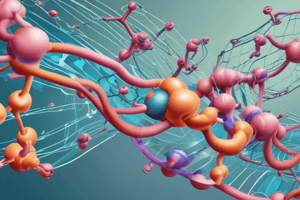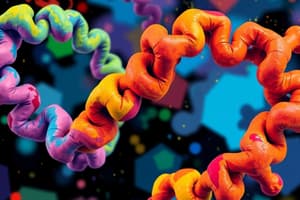Podcast
Questions and Answers
What is the primary factor that determines the choice of method for solving biomolecular structures?
What is the primary factor that determines the choice of method for solving biomolecular structures?
- Desired resolution of the final structure
- Size of the protein being studied
- Properties of the protein
- All of the above (correct)
What is the relationship between protein structure and function?
What is the relationship between protein structure and function?
- Protein structure is related to its 3D shape only
- Protein structure has no relation to function
- Protein structure is related to specific chemical or structural functions (correct)
- Protein structure is related to its size and properties
What is the primary force that stabilizes protein structures?
What is the primary force that stabilizes protein structures?
- Ionic interactions
- Hydrogen bonds
- Hydrophobic effect (correct)
- Disulfide bonds
What is the result of the packing of hydrophobic amino acids away from water in protein folding?
What is the result of the packing of hydrophobic amino acids away from water in protein folding?
What is the role of polar groups in protein folding?
What is the role of polar groups in protein folding?
What is the dielectric constant of the nonpolar protein interior?
What is the dielectric constant of the nonpolar protein interior?
What type of bonds constrain natural protein structures?
What type of bonds constrain natural protein structures?
What is the purpose of a Ramachandran plot?
What is the purpose of a Ramachandran plot?
What determines the tertiary structure of a protein?
What determines the tertiary structure of a protein?
What is the primary cause of many human diseases?
What is the primary cause of many human diseases?
What is quaternary structure?
What is quaternary structure?
What is necessary for some denatured proteins to refold into their active conformation?
What is necessary for some denatured proteins to refold into their active conformation?
Flashcards are hidden until you start studying
Study Notes
Protein Structure and Stability
- Protein structures are stabilized by noncovalent interactions and forces, including the hydrophobic effect, hydrogen bonds, ionic interactions, and van der Waals forces.
Secondary Structure
- Protein segments can adopt regular secondary structures such as the α helix and the β conformation, which are defined by particular values of dihedral angles φ and ψ.
- The formation of these structures is impacted by the amino acid composition of the segment.
Tertiary Structure
- Tertiary structure describes the well-defined, three-dimensional fold adopted by a protein.
- Protein structures are often built by combinatorial use of common protein folds or motifs.
Quaternary Structure
- Quaternary structure describes the interactions between components of a multisubunit assembly.
Relationship Between Protein Structure and Function
- The three-dimensional structures of proteins can be defined.
- Structural biologists use a variety of instruments and computational methods to solve biomolecular structures.
- Protein function relates to unique three-dimensional structures.
Conformations and Stability
- Proteins can assume an uncountable number of special arrangements, or conformations, but only a limited number of conformations predominate under biological conditions.
- Conformations are thermodynamically the most stable, with the lowest free energy (G).
- Unfolded proteins have high conformational entropy, and chemical interactions stabilize native conformations.
Weak Interactions and Forces
- Protein conformations are stabilized largely by weak interactions, including hydrogen bonds, the hydrophobic effect, and ionic interactions.
- The hydrophobic effect is the predominating weak interaction, causing nonpolar groups to cluster together and decrease the solvation layer.
- Hydrogen bonds and ion pairs contribute to protein folding, with repeating secondary structures optimizing hydrogen bonding and ion pair interactions.
Studying That Suits You
Use AI to generate personalized quizzes and flashcards to suit your learning preferences.




